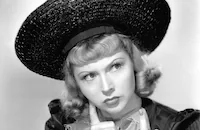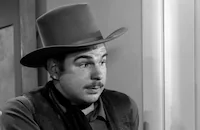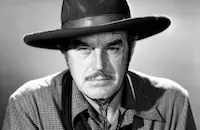A Southern Yankee

Brief Synopsis
Cast & Crew
Edward Sedgwick
Red Skelton
Brian Donlevy
Arlene Dahl
George Coulouris
Lloyd Gough
Film Details
Technical Specs

Synopsis
At the Palmer Hotel in St. Louis in 1865, the bumbling bell boy Aubrey Filmore dreams of catching Confederate spies. He asks the head of the Union Secret Service, Colonel Clifford M. Baker, if he can join his elite group, but Baker once again refuses. Soon after, Baker tells his men to post notices warning about a dangerous Confederate spy nicknamed The Grey Spider. The next day, Major Jack Drumman comes to the hotel and when Aubrey discovers that he is really The Grey Spider, he forces Aubrey to change uniforms with him and plans to shoot him, thus making everyone to believe that the spy is dead. Just as Aubrey accidentally knocks out Drumman, Drumman's accomplice, the beautiful Sallyann Weatharby, appears at the door and Aubrey immediately falls in love. Pretending to be Drumman, Aubrey goes along with her to a meeting of the top Confederate spies, tipping off Baker before he leaves the hotel. At the meeting, Aubrey receives the Union battle plans, which he is to deliver to Confederate General Watkins, and is told to meet Sallyann at Morgan's Landing, a hospital at the battlefront. When he returns to the colonel, Baker falsifies the battle plans and reluctantly gives them to Aubrey to take across the enemy lines, still posing as Drumman, and deliver them to a Union spy in the South. Aubrey places the fake battle plans in his jacket and the instructions for the spy in his boot, but seems confused about which is where. At the front, Aubrey tries to escape by walking down the middle of the battle line wearing half of the Confederate uniform and half of the Union uniform, but is attacked by both sides. He is then taken unconscious to Morgan's Landing, where Sallyann waits for him and tells her jealous fiancée, Kurt Devlynn, that she now loves Drumman. After a series of mishaps in the hospital, Aubrey finds the boots and jacket with the information and escapes. Meanwhile, Devlynn tells his cohort, Captain Jed Calbern, to dress his men as Union soldiers, ambush Drumman and steal the plans. Aubrey, thinking that Jed's men are allies, unintentionally confuses them and they run off. At the plantation of Sallyann's father Colonel Weatharby, Aubrey gives Weatharby the spy instructions instead of the battle plans, sparking a long chain of events in which Aubrey, his Union contact Captain Steve Lorford, Devlynn and Jed repeatedly switch and steal the two sets of papers, until finally the battle plans get into General Watkins' hands and Lorford gets the instructions. At a party that night, Lorford tells Aubrey to obtain the Confederate battle plans from Watkins and bring them back them to Colonel Baker, but Aubrey dawdles to court Sallyann, who insists on a quick marriage. Meanwhile, Devlynn knows that a Union spy is in the house and the Confederates set a trap for him, but manage only to capture the true Grey Spider, who has escaped from the Union prison and returned to the plantation to carry out his original mission. Believing that the real Drumman is actually the Yankee spy, Watkins gives the plans to Aubrey, but just then Drumman's father, who has secretly been invited to the wedding by Sallyann, arrives and identifies the real Drumman as his son. With Aubrey's deceit now revealed, he is taken out to be shot, but is rescued by a still-loving Sallyann just as the war is declared over.

Cast

Red Skelton

Brian Donlevy

Arlene Dahl

George Coulouris

Lloyd Gough

John Ireland

Minor Watson

Charles Dingle
Art Baker
Reed Hadley
Arthur Space

Joyce Compton

Addison Richards

Paul Harvey

Jeff Corey
Cliff Clark
Dick Wessel
Ian Macdonald
John Hilton
Ed Gargan
David Sharpe
Sam Ash
Ralph Brooks
Douglas Carter
William Norton Bailey
Frank Pharr
Frank Mcgrath
David Newell
Wesley Hopper
Lane Chandler
Carl Saxe
Bill Hall

Matt Willis
Jeff York
Jake Harrison
William Tannen
Stanley Andrews

Roger Moore
Dick Simmons
Susan Simon

Byron Foulger
Paul Newlan
Buddy Roosevelt
Marcus Turk
Ralph Montgomery
Walter Merrill
Ralph Volkie
Stephen Bennett
Allen Mathews
Wm. "bill" Phillips
Garry Owen
George Denormand
George Magrill
James Horne

Bob Wilke
Ben Moselle
Jack Worth
Brad Slaven
Harry Wilson
Ann Staunton

Harry Woods
Drexle Bobbie Haywood
Shelby Bacon
Dick Alexander

Harry Cording
Kermit Maynard
John Merton
Frank Hagney
Sam Flint
Weldon Heyburn
Jack Lee
Forbes Murray

Pierre Watkin
Rod O'connor
Bert Moorehouse
Bill Kennedy
Henry Hall
James Logan

Howard Mitchell
Paul Krueger
Victor Zimmerman
Chris Frank
Wade Crosby
Gene Stutenroth
Jack Stoney

Glen Strange
Crew
John Banse
Jack Dawn
Dale Deverman
Randall Duell
Melvin Frank
Cedric Gibbons
Sydney Guilaroff
Jerry Hester
Paul Jones
Ray June
Arthur Krams
Ben Lewis
Earl Mcevoy
Warren Newcombe
Norman Panama
Sergei Petschnikoff
Mervyn Price
Douglas Shearer
David Snell
Harry Tugend
Valles
John A. Williams
Edwin B. Willis

Photo Collections
Videos
Trailer
Hosted Intro
Film Details
Technical Specs

Articles
A Southern Yankee
The narrative opens in Civil War-era St. Louis, where bumbling bellboy Aubrey Fillmore (Skelton) fantasizes about the military service for which he was deemed unfit. As dumb luck would have it, he plays a fortuitous role in the unexpected capture of the notorious Rebel spy Major Jack Drumman (George Coulouris), AKA "The Gray Spider". As a reward for his dubious heroism, Aubrey is enlisted to assume the role of the Spider, and is sent South in a bid to recover critical military secrets to which the spy would be privy. Once in the field, Aubrey has a constant struggle to keep from blowing his cover, particularly after he begins courting southern belle Sallyann Weatharby (Arlene Dahl).
Over time, Keaton's genius as a filmmaker has been recognized, but the silent-era star kept a low profile during the 1940s, receiving piecework from Hollywood in the form of gag-writing behind the scenes and occasional character roles onscreen. He was conscious of Skelton's comic potential, so much so that he sought personal audience with Louis B. Mayer. "In the inner sanctum he surprised himself with an eloquence he had never been able to summon in his own behalf," Rudi Blesh recounted in his biography Keaton. "'Let me take Skelton,' he said, 'and work as a small company within Metro--do our stories, our gags, our production, our directing. Use your resources but do it our way--the way I did my best pictures. I'll guarantee you hits,' he said. 'I won't take a cent of salary until they have proved themselves at the box office.'"
Mayer didn't bite, and the history of film comedy is probably the poorer for it. Ultimately, Keaton's input into A Southern Yankee would not be insubstantial. The comic recounted in his autobiography My Wonderful World of Slapstick how his advice was solicited after the film's disappointing early previews. "[I]n my opinion, they made a couple of mistakes," Keaton wrote. "One was having Red behave like an imbecile in the opening scenes. As the comedian and the leading man, Red lost the audience's sympathy by behaving too stupidly...They reshot those scenes, toning down Red's nutty behavior and also eliminating some of the noise that marred the opening scene."
After the original director left the project, the reins (and final credit) were handed to Edward Sedgwick. The semi-retired veteran vaudevillian had directed Keaton's most notable MGM vehicles of the late 20s and early 30s, including The Cameraman (1928), Spite Marriage (1929), Free and Easy (1930) and Speak Easily (1932). Keaton was also responsible for the movie's famous signature gag, where Skelton attempts to cross a battlefield unscathed by wearing a stitched-together uniform, Union blue on one side, Confederate gray on the other. Both sides stop shooting and cheer this brave standard bearer, at least until the wind catches the flag and flips it from stars and stripes to stars and bars.
Producer: Paul Jones
Director: Edward Sedgwick
Screenplay: Melvin Frank, Buster Keaton, Norman Panama, Harry Tugend
Cinematography: Ray June
Film Editing: Ben Lewis
Art Direction: Randall Duell, Cedric Gibbons
Music: David Snell
Cast: Red Skelton (Aubrey Filmore), Brian Donlevy (Kurt Devlynn), Arlene Dahl (Sallyann Weatharby), George Coulouris (Major Jack Drumman), Lloyd Gough (Capt. Steve Lorford), John Ireland (Capt. Jed Calbern).
BW-91m.
by Jay S. Steinberg

A Southern Yankee
Quotes
Trivia
Notes
The working title of this film was The Spy. S. Sylvan Simon, who directed the principal filming of the picture, did not receive a screen credit. Simon, who had made several pictures at M-G-M, left the studio after principal production on the film ended in February 1948. A Hollywood Reporter news item indicates that Edward Sedgwick was assigned to direct the film in May 1948, when two weeks of added scenes were ordered. Sedgwick directed many films in the silent era, and this picture marked his first film since Air Raid Wardens (1943, ). Red Skelton's biography, relating information provided by screenwriter Harry Tugend, indicates that Skelton did not want to appear in the film. Tugend claimed that Skelton "deliberately dogged" the production in the hope that M-G-M would release him from his contract. Modern sources indicate that silent comedian Buster Keaton wrote sight gags for the film. While some modern sources also call the film a re-working of the 1926 Keaton silent film The General, the two films bear few similarities.


















